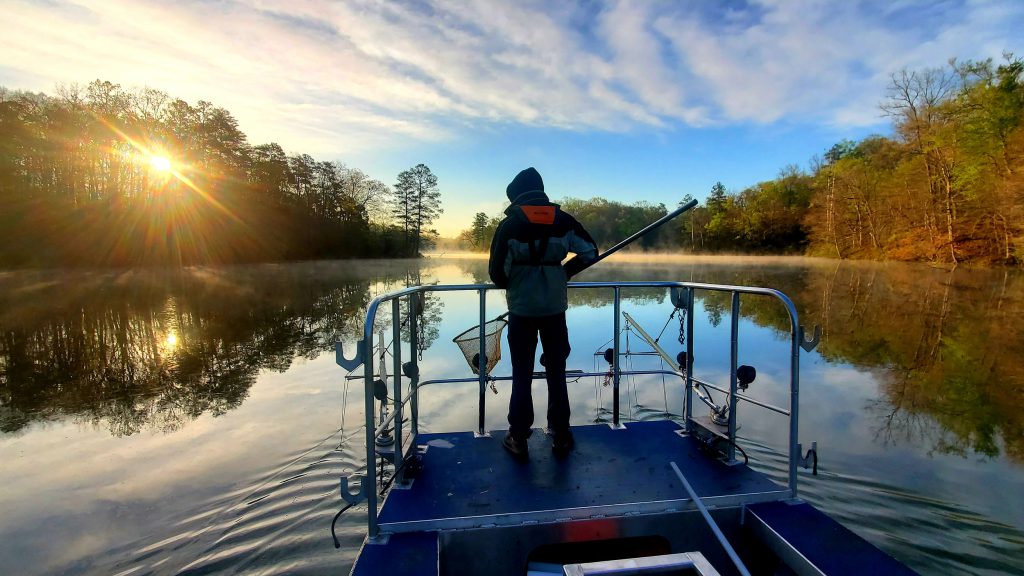
Fall is almost here, and it’s a favorite time of the year for most people. Everything from the cooler weather to pumpkin spice lattes and seasonal festivities makes it a season to savor and enjoy. However, fall comes with a ton of responsibilities for lake and pond owners. This is the time to evaluate your fishery’s health and work with a pond management service in Marietta, GA to keep your aquatic ecosystem thriving through changing conditions.
The changes in water conditions can slow down the metabolism of fish and other aquatic organisms. Besides, fish behavior tends to shift in the fall as well. This includes changes in feeding patterns, migration habits, and spawning activities. Here at Aquatic Restoration, we pride ourselves on offering professional pond and lake management services. Our specialists understand what happens within your aquatic ecosystem during these seasonal transitions. In today’s blog post, we share four practical ways to evaluate the health of your fishery in the fall.
Water quality is the foundation of a healthy fishery, and fall is the perfect time to check key parameters before winter sets in. Test for pH, dissolved oxygen, ammonia, nitrate, and alkalinity to gain insight into whether conditions are stable. Fluctuations in these levels can stress fish and make them more vulnerable to disease and poor growth. Regular testing helps you detect issues early and take corrective action, such as aeration adjustments or nutrient management, to maintain a thriving ecosystem.
Take time to observe your fish in the fall in order to establish their overall health and behavior. Pay attention to their activity levels, feeding habits, and any visible signs of stress or illness, such as discoloration, unusual swimming patterns, or sores. If fish are sluggish or not eating as much, it could be a sign of water quality issues, parasites, or disease. In addition, make sure you watch for signs of overcrowding or aggressive behavior.
A well-balanced fishery depends on maintaining the right mix of species, sizes, and overall numbers. Fall is a great time to conduct a population assessment to see if certain species are overpopulated or underrepresented. One way to do this is to use net surveys, electrofishing, or even simply tracking your catch data over the season. If you notice stunted growth or an imbalance in predator-to-prey ratios, it may be time to consider restocking or adjusting your harvest strategy.

A fishery’s health isn’t just about the fish—it’s also about their environment. It’s a good idea to assess habitat quality in the fall to identify any areas that need improvement before winter. Look at factors like aquatic vegetation, shoreline stability, and water depth. Overgrown vegetation can lead to oxygen depletion, while excessive siltation can reduce spawning grounds. Fallen trees or artificial structures can provide essential cover for fish. If you notice shallowing depth or excessive algae growth, consider scheduling lake dredging service to maintain a healthy aquatic environment.
There’s a lot that goes into maintaining a healthy fishery and ensuring your aquatic ecosystem is thriving. Nothing beats the feeling of catching bass in a well-managed body of water. As a pond owner, it’s important to work alongside a trusted lake management service to enhance your fishery’s health. If you need help with enhancing your fishery’s health, get in touch with Aquatic Restoration. Our team can help you with lake dredging, shoreline stabilization, retention pond maintenance, spillway renovation, and more.
If you own a pond or lake, you know that proactive maintenance is an integral part of keeping the…
If you’ve ever walked outside and noticed your lake suddenly turn a murky shade of green, you’re not alone. Many…
Lakes are vital ecosystems that support wildlife, protect water quality, and enhance the quality of life for surrounding communities. Whether…
If you’re reading this, there’s a good chance you’re sick and tired of dealing with aquatic weeds that never…
Lake management is an integral part of keeping lakes healthy, functional, and beautiful for generations to come. Not only…